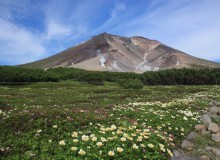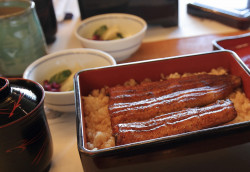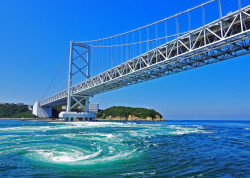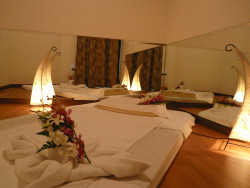
October 6, 2025
A Guide to the Best Spots to Surf in Japan
Kyushu: Japan’s Surfing Island
By Matt Dursum
A surfing boom is being experienced in Japan, with the sport being embraced by more people than ever before. Among the country’s wave-rich coastlines, Kyushu Island — located in the far south — is increasingly recognized as a world-class surfing destination. Although wave consistency is not always guaranteed, the quality and variety of breaks are considered more than sufficient to compensate. Supported by a passionate local surf community, Kyushu is steadily being placed on the global surf map.
The Waves
Waves are typically categorized by the shoreline contours they break over. A reef creates a reef break, a sandy bottom forms a beach break, an abrupt slab of reef is known as a slab, and a long curved coastline becomes a point break. All of these types can be found along Kyushu’s curving shores. When distant typhoons, Siberian cold fronts, or local monsoons occur, wave energy is generated and is carried easily into the island’s beaches, bays, and inlets.
Surfable waves can be accessed along nearly every coast of Kyushu. The island’s north is more populated and less consistent than the south, yet it still has quality waves throughout the year. Fukuoka, the island’s largest city, gets wave energy from the Sea of Japan. The nearby Itoshima peninsula and Futamigaura Beach are the most consistent spots near the city and work best in the winter.
The East Coast and Hioki
The island’s eastern coastline, stretching from Saga to Kagoshima, is filled with surfing potential. In winter, these spots are illuminated, and a range of setups can be explored simply by driving along Highways 3 and 270. In Kagoshima’s city of Hioki, Ei-Guchi Hama is frequented by local surfers. Waves here are somewhat consistent, often crowded, and occasionally produce beautifully challenging conditions.
Surf Culture in Ei
On the southern end of Kagoshima’s Satsuma Peninsula sits the small town of Ei, where green tea fields and one of Japan’s most strikingly photogenic volcanoes paint the coastline. Here, Daichi Ikemizu became prompted to start the summer X-games-inspired event called Ibusuki Summer Breeze. Held in the town of Ibusuki, this one-day event provides surfing and skating lessons for young people, live music and environmental outreach.
When asked about his inspiration, Ikemizu says, “I noticed the lack of choices for ‘things to dream about’ given to Japanese boys and girls. Boys play soccer or baseball, and girls play volleyball and badminton. I wanted to offer new options such as surfing and skateboarding.” Ikemizu’s message is simple: develop a love for surfing and the environment in local children and secure the health of the wave-rich coast for future generations.
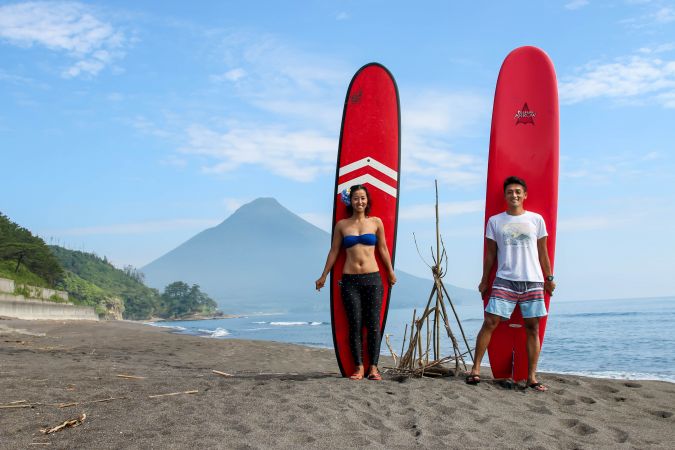
Surfing’s Roots in Kyushu
Surfing was first introduced to Japan at the end of World War II, when American military personnel brought wave riding to Yokosuka. The sport quickly spread to Kyushu and flourished in Miyazaki. For decades, the city and the nearby Nichinan coast benefited from domestic tourism, promoted as a subtropical honeymoon destination. Its laid-back vibe and palm-lined beaches attracted ocean lovers, who became champions of the local surf culture.
International competitions were eventually hosted in Miyazaki, where the world’s top athletes competed in excellent conditions. Local pride for Miyazaki’s quality surf exploded, and so too did the city’s competitive drive. All this culminated in a thriving surf community that’s a breeding ground for Japanese professional surfing talent.
Surf Spots of Miyazaki
Miyazaki’s coastline — from Nobeoka in the north to Shibushi in Kagoshima Prefecture — is lined with beaches, reefs, and point breaks. To the north lies Okuragahama, a consistent beach break ideal for beginners. Within Miyazaki City, the most renowned wave is Kisakihama, a beach break famous for hosting major competitions, including the ISA World Games — an Olympic qualifying event for surfing’s debut.
Interested in exploring this region beyond the waves? Check our: Nobeoka, Miyazaki: Seaside Jewel of Kyushu.
Aoshima
Further south lies Aoshima, a town celebrated for its SoCal-style beach break. Palm trees, crowded lineups, and surf tourism reminiscent of Australia’s Gold Coast have established Aoshima as Kyushu’s surfing capital. If you’re in the market for surfboards, lessons, or apparel, this is your destination.
Further south, things become wondrous. South of Aoshima, Kyushu’s wave power reaches legendary status. In 1991, North American world champion Tom Curren famously paddled into a remote break during Typhoon Orchid. The storm produced waves exceeding 30 feet, and Curren’s ride over a jagged reef became one of the most iconic moments in Japanese surfing history. The spot has since been known as Curren’s Point, forever altering global perceptions of Japan’s surf quality.
From Curren’s Point south is the rugged Nichinan coastline. This area is for experienced surfers only, and many of these spots are localized. During strong typhoons, large waves roar onto the shallow reefs here, producing fast and hollow waves that are perfect training grounds for pros. It’s a spectacle to witness.
For a completely different kind of getaway, check out our Escape to Zaltana Cabin in the Mountains of Nagano, for serene mountain views.
This article was originally published on April 7, 2022, but has been updated in October 2025 for accuracy.

